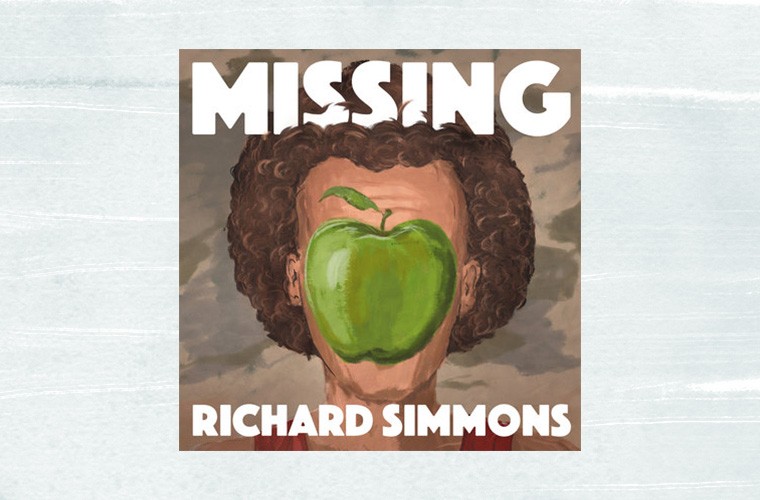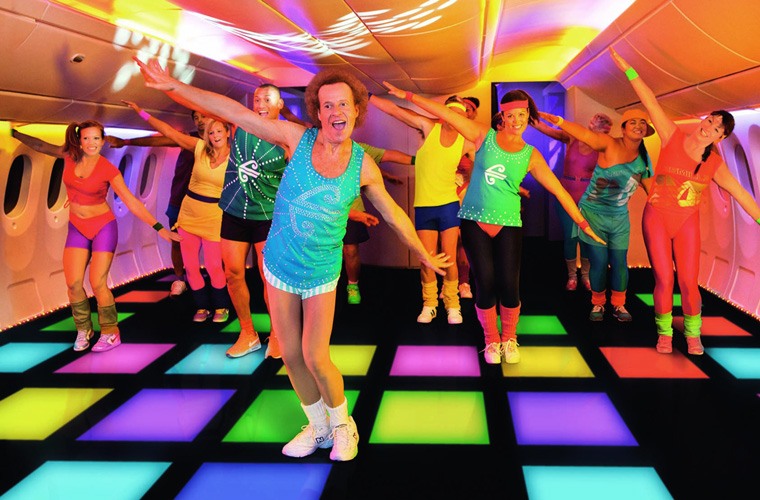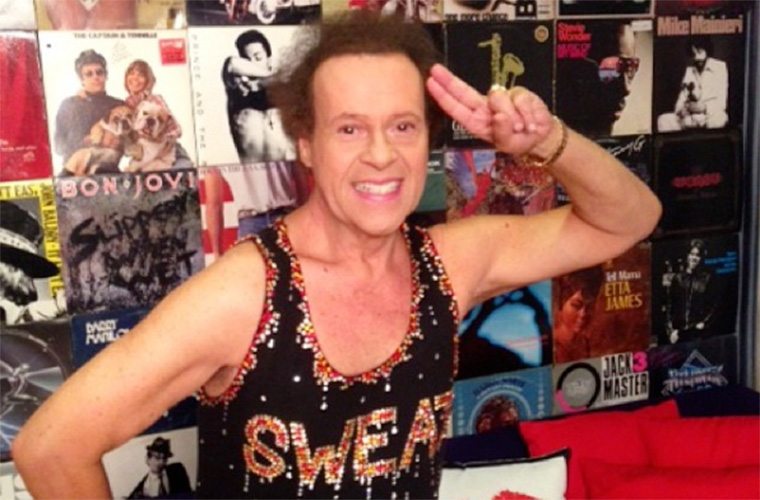Why Everyone Is Obsessed With a Fitness Podcast About Richard Simmons
If you instinctively grabbed your smartphone this morning to get your fix of Missing Richard Simmons only to remember, heartbroken, that the hit podcast is over, do not despair.
I don’t have a secret bonus episode, nor have I located the elusive, eccentric aerobics legend in some rhinestone-studded safe house. But as a historian of American fitness culture, I do have some thoughts on why the podcast—six episodes of sweaty, if not salacious, stories that tell us nothing about how to get thin thighs or flat abs—went viral, and what our particular fascination with Simmons says about our relationship to the gym today.
The tale of the missing gym hero is so gripping, I think, because the figure of the #fitpro that we know, love, and follow today wouldn’t exist without Richard Simmons.
ICYMI: In Missing Richard Simmons, former producer of The Daily Show Dan Taberski searches for the Sweatin' to the Oldies superstar, whose abrupt 2014 exit from the spotlight he had relentlessly sought since the 1960s had millions of fans wondering about a nervous breakdown, elder abuse, or even abduction.
Spoiler alert: Taberski never finds Simmons, who had been his instructor and acquaintance. (The podcaster called off the manhunt after the LAPD did a welfare check and reported that Simmons was "fine.") But he takes listeners on a tour through the sweaty, sequined subculture that made Simmons a celebrity, from New Orleans, where he was born Milton Teagle Simmons in 1948, an era when “exercise” might mean hitting the slenderizing salon in heels, to his Los Angeles studio, Slimmons. Comparisons to the addictive Serial podcast came fast and furious:
https://twitter.com/SavvyAuntie/status/836918013140025345

{{post.sponsorText}}
Then came the endless think pieces about the ethics of tracking down someone who doesn’t want to be found.
https://twitter.com/BenRothenberg/status/843489596184969216
But the essential question is: Why do so many people care about Richard Simmons? Especially the relatively young podcast demographic, comprised of listeners who were barely old enough for gym class in the 1980s and 1990s, when Simmons was amassing his massive fan base through VHS tapes, the daytime talk-show circuit, and special events like his Carnival “Cruise to Lose” trip.
The tale of the missing gym hero is so gripping, I think, because the figure of the #fitpro that we know, love, and follow today—health expert, bike-seat therapist, DJ, confidante, fashion icon, and celebrity in her own right—wouldn’t exist without Simmons.
Whether he emerges from (self-imposed, we hope) exercise exile or not, Simmons' legacy is everywhere.

He said the f-word
Today, an ascendant body positivity makes unapologetic “thinspo” feel so outdated that openly discussing dieting has been called the “last feminist taboo.” Even in the early 1970s, when Simmons founded his studio (then called Anatomy Asylum), fellow fitness pioneers like Jazzercise's Judi Sheppard Missett and Jane Fonda emphasized the “joy” and “health”—rather than weight-loss—benefits of exercise in order to challenge oppressive beauty standards. Such feminist intentions notwithstanding, these '80s aerobics goddesses themselves embodied (and implicitly normalized) a slightly more muscled version of the conventionally attractive slim, white, blonde ideal.
Countless people struggling to lose weight tearfully recall Simmons as the only person in a fat-hating culture who truly “saw” them.
Simmons was anything but conventional in his signature short shorts, sparkly tank top, and fuzzy curls, and he embraced diet talk—speaking (and singing) about his deliverance through exercise from life as a “former fattie.” He featured larger people in his videos, and as Taberski recounts, countless people struggling to lose weight tearfully recall Simmons as the only person in a fat-hating culture who truly “saw” them.
Simmons unquestionably contributed to the damaging idea that fat people only deserve sympathy when they're striving for thinness, but his earnestness about his own journey—combined with his welcoming of people of all shapes and sizes—helped make fitness more accessible than intimidating.

Third place, safe space
Simmons may have unapologetically focused on old-fashioned weight control, but he was also a pioneer in making the gym more than a place for exercise alone. In his 1999 memoir, Still Hungry After All These Years, Simmons remembers his breakthrough idea (which now seems totally obvious): to create a space where “you could eat healthy and exercise—all under one roof.”
He proudly opened Ruffage (get it?) adjacent to the Asylum, the first free-standing salad bar in LA (the others were inside steakhouses). Soon, instructors and students were hanging around before and after class, “healthy, exercising, and feeling good…there was such camaraderie and motivation that seemed to build everyday.”
Gay men often speak of the safety they felt in his studio and his mainstream popularity arguably helped demystify gay culture.
Simmons, who sometimes wore makeup and dressed as a woman, never spoke publicly about his sexuality, but gay men often speak of the safety they felt in his studio and his mainstream popularity arguably helped demystify gay culture.
Exercise, Simmons declared (often while snapping a sweaty shirt at one of the bare-chested men who frequented Slimmons), was about the joy of celebrating rather repressing the body. The outlet wasn’t just about dancing to disco like no one was watching; gyms were often rare spaces of solace for gay men during the HIV-AIDS epidemic of the 1980s. Interestingly, for all that physical freedom, privacy was paramount—photos inside Slimmons, for example, were strictly forbidden. As Molly Fox, owner of the eponymous 1990s New York City studio remembers, the gym “was like a third place for all of us.”

A star instructor is born
Throughout the podcast, many of the mysterious star’s acquaintances hint that Simmons’ over-the-top energy masked a quieter, perhaps sadder, self. True or not, Simmons made the “celebrity trainer” a new fixture on the fitness scene. His students remember his classes over four decades as performances, complete with adoring throngs of fans.
Simmons was unique among this new class of sweaty celebs, often opening class by sharing teary personal anecdotes, and befriending and coaching the fans who wrote him thousands of personal letters detailing their fears and illnesses.
Simmons was unique among this new class of sweaty celebs, often opening class by sharing teary personal anecdotes, and befriending and coaching fans.
Three decades before Oprah went on a motivational tour with top SoulCycle talent, she interviewed Simmons on her Baltimore local-access TV show; he was an emerging fitness expert-slash-lifestyle guru—a role that's so familiar today.
And judging from the response to Missing Richard Simmons, the oddball charm that got him on TV in the first place (and helped him build today's fitness industry) is still potent, even in his absence. After all, the world Simmons helped create isn’t perfect—from promoting diet culture to minimizing the importance of professional expertise—but without him? It would just be the gym.
 Meet Well+Good’s fitness historian, Natalia Petrzela, PhD, a history professor at The New School in New York City and a premier IntenSati instructor, who shares how the sweaty past informs the present in this column.
Meet Well+Good’s fitness historian, Natalia Petrzela, PhD, a history professor at The New School in New York City and a premier IntenSati instructor, who shares how the sweaty past informs the present in this column.
More fitness history lessons: Wellness has always played an important role in politics and activism—though there was a time when healthy living was considered, well, weird.
Loading More Posts...